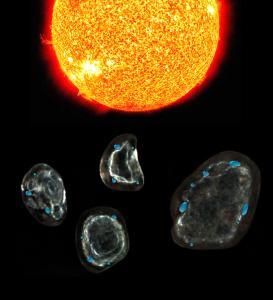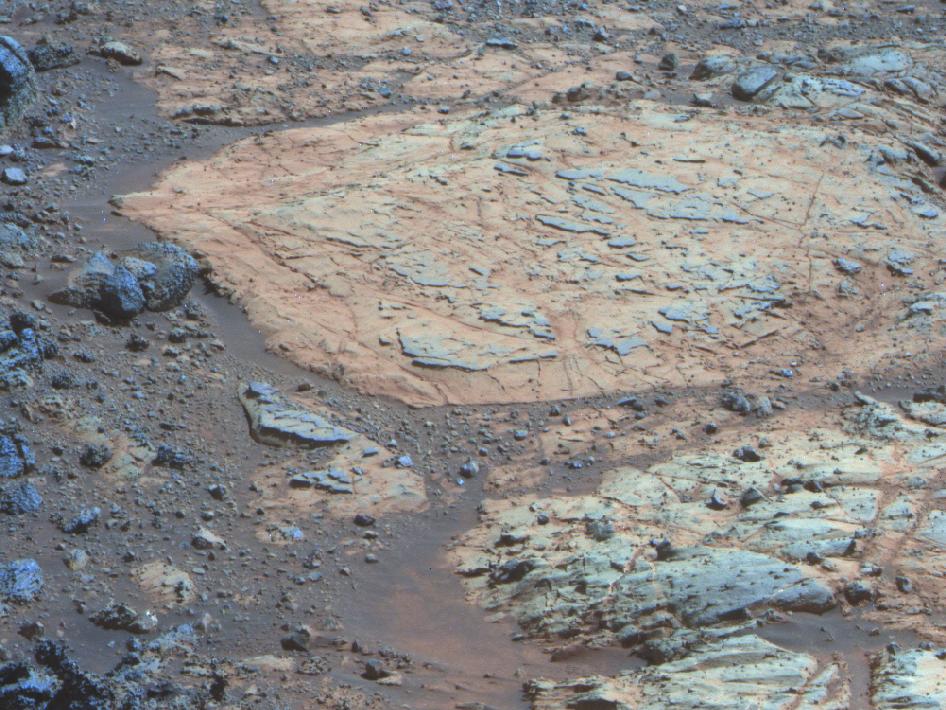Interplanetary dust particles carry water and organics
January 29, 2014

Interplanetary dust particles carry water generated with hydrogen solar wind + oxygen from silicate mineral grains (credit: John Bradley)
Interplanetary dust particles could be delivering water and organics to the Earth and other terrestrial planets scientists have found.
Interplanetary dust — dust that has come from comets, asteroids, and leftover debris from the birth of the solar system — continually rains down on the Earth and other Solar System bodies.
These particles are bombarded by the solar wind, predominately hydrogen ions. This ion bombardment knocks the atoms out of order in the silicate mineral crystal and leaves behind oxygen that is more available to react with hydrogen to create water molecules.
“It is a thrilling possibility that this influx of dust has acted as a continuous rainfall of little reaction vessels containing both the water and organics needed for the eventual origin of life on Earth and possibly Mars,” said Hope Ishii, new Associate Researcher in the Hawaiʻi Institute of Geophysics and Planetology (HIGP) at the University of Hawaiʻi and co-author of the study.
This mechanism of delivering both water and organics from stars would also work for their exoplanets.
Water and organics delivered together
Airless bodies in space such as asteroids and the Moon, with ubiquitous silicate minerals, are constantly being exposed to solar wind irradiation that can generate water. In fact, this mechanism of water formation would help explain remotely sensed data of the Moon, which discovered OH and preliminary water, and possibly explains the source of water ice in permanently shadowed regions of the Moon.
“Perhaps more exciting,” said Hope Ishii, Associate Researcher in HIGP and co-author of the study, “interplanetary dust, especially dust from primitive asteroids and comets, has long been known to carry organic carbon species that survive entering the Earth’s atmosphere, and we have now demonstrated that it also carries solar-wind-generated water. So we have shown for the first time that water and organics can be delivered together.”
Using a state-of-the-art transmission electron microscope, the scientists have now actually detected water produced by solar-wind irradiation in the space-weathered rims on silicate minerals in interplanetary dust particles. And based on laboratory-irradiated minerals that have similar amorphous rims, they were able to conclude that the water forms from the interaction of solar wind hydrogen ions (H+) with oxygen in the silicate mineral grains.
Scientists at Lawrence Livermore National Laboratory, Lawrence Berkeley National Laboratory, and University of California – Berkeley were also involved in the research.

Opportunity’s view (in false-color) of ancient mudstones on a rocky outcrop on the rim of Endeavor Crater (credit: NASA/JPL/Cornell/ASU)
Mars had liquid water 4 billion years ago
Supporting this finding, a team of scientists has found that around four billion years ago, Mars had liquid water so fresh it could have supported life, based on a study of the oldest minerals ever analyzed by NASA’s Mars Opportunity Rover.
The findings were announced in a special “Exploring Mars Habitability” edition of the journal Science to coincide with the 10th anniversary of the Mars Opportunity Rover and its twin, Spirit, landing on the red planet.
“Our latest research has found not only the earliest episode of water activity documented yet by the Opportunity Rover, but that the geochemistry of the 4 billion year old rocks indicates extensive deposits of past water that’s among the freshest, most life-sustaining found so far anywhere on Mars,” said CSIRO‘s Dr Paulo de Souza
“If there was ever life on Mars, then this would have been the mud for it to live in.”
Abstract of Proceedings of the National Academy of Sciences paper
The solar wind (SW), composed of predominantly ∼1-keV H+ ions, produces amorphous rims up to ∼150 nm thick on the surfaces of minerals exposed in space. Silicates with amorphous rims are observed on interplanetary dust particles and on lunar and asteroid soil regolith grains. Implanted H+ may react with oxygen in the minerals to form trace amounts of hydroxyl (−OH) and/or water (H2O). Previous studies have detected hydroxyl in lunar soils, but its chemical state, physical location in the soils, and source(s) are debated. If −OH or H2O is generated in rims on silicate grains, there are important implications for the origins of water in the solar system and other astrophysical environments. By exploiting the high spatial resolution of transmission electron microscopy and valence electron energy-loss spectroscopy, we detect water sealed in vesicles within amorphous rims produced by SW irradiation of silicate mineral grains on the exterior surfaces of interplanetary dust particles. Our findings establish that water is a byproduct of SW space weathering. We conclude, on the basis of the pervasiveness of the SW and silicate materials, that the production of radiolytic SW water on airless bodies is a ubiquitous process throughout the solar system.
Abstract of Science paper
Opportunity has investigated in detail rocks on the rim of the Noachian age Endeavour crater, where orbital spectral reflectance signatures indicate the presence of Fe+3-rich smectites. The signatures are associated with fine-grained, layered rocks containing spherules of diagenetic or impact origin. The layered rocks are overlain by breccias, and both units are cut by calcium sulfate veins precipitated from fluids that circulated after the Endeavour impact. Compositional data for fractures in the layered rocks suggest formation of Al-rich smectites by aqueous leaching. Evidence is thus preserved for water-rock interactions before and after the impact, with aqueous environments of slightly acidic to circum-neutral pH that would have been more favorable for prebiotic chemistry and microorganisms than those recorded by younger sulfate-rich rocks at Meridiani Planum.